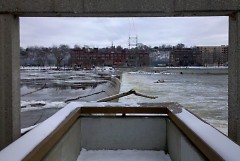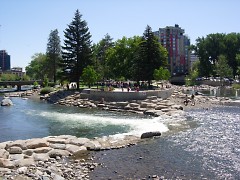Grand Rapids Mayor George Heartwell included recommendations from Green Grand Rapids in his annual State of the City address on Saturday, January 30th. Among several important, yet ho-hum initiatives listed in the address, such as “manage stormwater,” one of the objectives stood out: “Return the Rapids to the Grand.” The list of cities to undertake similar river restoration and renewal is a “who’s who” list of America’s coolest cities.
Cities like Denver, Reno/Tahoe, Missoula (click to see video) and Golden all have whitewater kayak parks. These parks are often accompanied by river habitat and vegetation restoration, woven into an urban park environment that makes the rivers the focal point. All of these rivers have checkered pasts of neglect, crime along their banks and polluted waters.
Rapids on the Grand is the brainchild of Chip Richards, a kayak enthusiast who first imagined a kayak course in the Grand River in 2000. Eventually he met Chris Mullins who shared the same dream. Last year they created grandrapidswhitewater.com and a Facebook page. The Facebook page now has over 4,200 fans.
According to Richards, the plan is a win-win. Even those who are initially skeptical are soon won over by the facts. For example, the Steelheaders who cherish the current dam and fish ladder configuration initially objected to the idea. But once they listened to Richards simple plan which is to “advance the idea of returning the rapids to the Grand for everyone’s enjoyment,” the doubters become supporters.
The Steelheaders are now some of the most vocal advocates, citing the improved fish habitat and fishing opportunities that will result. “Whitewater helps increase oxygen in the water which will improve fish and wildlife habitat,” says Richards. “Invest in the river and it will pay a huge return, especially since initial funding being sought is from private sources.”
The current dam structures, built in the 1930's, are dangerous. In the past year, three people have been extricated from gyres under the dam. Uniform water pouring over the current structure, known as a "low head dam" creates a continuous cyclone. This underwater vortex is nearly impossible to get out of, as evidenced by the frequency of logs and tires and debris regularly seen churning round and round below the dam.
The original dam's purpose in 1849, when construction began was to create a mill pond to funnel water through a canal on the east bank, and eventually a lock system that would allow boats to travel above and below the dam. In the canal, water turned water wheels which powered the industrial buildings on its bank such as the Waterworks and Brassworks buildings. Pulleys and gears powered the tools and equipment necessary for creating Grand Rapids first furniture factories. But the locks were never finished. The lower dams were part of another project designed to dredge and widen the river to keep water in it year round.
Before the dam was constructed the river consisted of a series of rapids between Sixth and Wealthy Streets which dropped 17.4 feet in elevation. The rushing water was such a danger to early traders and Native Americans that they would unload their canoes and barges for the portage or trade the goods on the bank between the top and bottom of the rapids. Eventually a store was created which was one of the first structures built in present day Grand Rapids.
This January the Downtown Development Authority granted a combined $30,000 for an engineering firm to study the hydrology and construct a kayak portage area above the dam, in anticipation of the Grand River Expedition 2010--a convoy of paddlers who will make the journey from the river's source to Grand Haven, and is expected to exceed 350 participants this year.
It is still early in the planning process and anything can happen. But the support by Grand Rapids citizens and leadership is a positive sign. The history of the river shows that this resource has been altered many times since the first explorers came to the region 300+ years ago. Rapids on the Grand may soon be a reality.
The Rapidian, a program of the 501(c)3 nonprofit Community Media Center, relies on the community’s support to help cover the cost of training reporters and publishing content.
We need your help.
If each of our readers and content creators who values this community platform help support its creation and maintenance, The Rapidian can continue to educate and facilitate a conversation around issues for years to come.
Please support The Rapidian and make a contribution today.




Comments
This would be sweet! I have never been in a kayak, but were this to happen I would hook up with one. This would definitely bring in more business to our downtown area. Great idea!